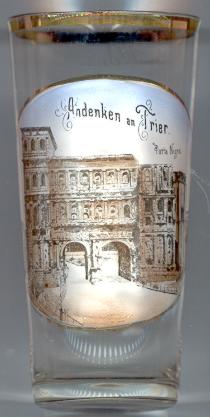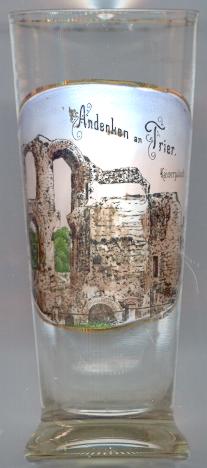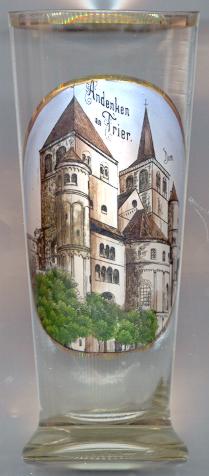

|
| DEUTSCHLAND | GERMANY |
| Bundesland: Rheinland-Pfalz | Rhineland-Palatinate |
| Stadt: Trier |
 Trier is Germany's oldest city with a history of more than 2000 years.
It was founded by the Roman emperor Augustus as Augusta Treverorum in 16 BC near the sanctuary of the Celtic tribe of the Treveri.
In 293 AD, Trier (then Treveris) became imperial residence under emperor Diocletianus and was the capital of the West Roman empire.
In the 5th century it was conquered by the Franks. When the Frankish kingdom was divided in 870, Trier became part of the East Frankish (German) part.
In the 12th century, the Archbishops of Trier obtained the rank of Electors, and Trier became the capital of the Electorate until the beginning of the 19th century.
After the Peace of Lunéville in 1801, Trier (Trèves) became part of France as capital (seat of the préfecture) of the département de la Sarre.
After the Congress of Vienna (1815), Trier became part of Prussia (Rhine province).
After World War II and the foundation of the Federal Republic of Germany it became part of the newly established state
of Rhineland-Palatinate in 1946.
The Roman monuments, the cathedral of St. Peter and the Church of Our Lady were listed as a UNESCO World Heritage site
in 1986 (see also list of other UNESCO heritage sites).
Trier is Germany's oldest city with a history of more than 2000 years.
It was founded by the Roman emperor Augustus as Augusta Treverorum in 16 BC near the sanctuary of the Celtic tribe of the Treveri.
In 293 AD, Trier (then Treveris) became imperial residence under emperor Diocletianus and was the capital of the West Roman empire.
In the 5th century it was conquered by the Franks. When the Frankish kingdom was divided in 870, Trier became part of the East Frankish (German) part.
In the 12th century, the Archbishops of Trier obtained the rank of Electors, and Trier became the capital of the Electorate until the beginning of the 19th century.
After the Peace of Lunéville in 1801, Trier (Trèves) became part of France as capital (seat of the préfecture) of the département de la Sarre.
After the Congress of Vienna (1815), Trier became part of Prussia (Rhine province).
After World War II and the foundation of the Federal Republic of Germany it became part of the newly established state
of Rhineland-Palatinate in 1946.
The Roman monuments, the cathedral of St. Peter and the Church of Our Lady were listed as a UNESCO World Heritage site
in 1986 (see also list of other UNESCO heritage sites).

The  Porta Nigra [left] is the best-preserved Roman city gate north of the Alps.
It was built around 160 AD. The largest of its sandstone building blocks weigh more than 6,000 kg. Unlike many other buildings of the Roman period,
the Porta Nigra was not used as a quarry in later periods, as the east tower was used by the Greek monk Simeon for his hermitage after 1028.
After his death in 1035 he was buried here and canonized by the church soon after.
Porta Nigra [left] is the best-preserved Roman city gate north of the Alps.
It was built around 160 AD. The largest of its sandstone building blocks weigh more than 6,000 kg. Unlike many other buildings of the Roman period,
the Porta Nigra was not used as a quarry in later periods, as the east tower was used by the Greek monk Simeon for his hermitage after 1028.
After his death in 1035 he was buried here and canonized by the church soon after.
The  Imperial Thermae [right] are the youngest of Trier's there Roman baths. The imperial baths were
built at the beginning of the 4th century AD and were among the largest baths of the Roman empire. During the Middle Ages, they were used as quarry.
Imperial Thermae [right] are the youngest of Trier's there Roman baths. The imperial baths were
built at the beginning of the 4th century AD and were among the largest baths of the Roman empire. During the Middle Ages, they were used as quarry.

The  cathedral of Trier [left] is located above the foundations of the palace of emperor Constantinus.
In 330 AD the palace was demolished and replaced by an enormous Christian church. It was one of the four churches built by Constantinus for his 20th jubilee as
emperor (the others were St. Peter in Rome, the church of the Holy Sepulchre in Jerusalem, and the church of the Nativity in Bethlehem).
The church was about four times the size of today's cathedral and was the largest church of its time. Parts of the Roman church
are still preserved in the cathedral (some walls up to a height of 25 m). After destructions in the 5th and 9th centuries the church was rebuilt and enlarged in Romanesque style.
The southern half of the Roman church was demolished around 1200 and was replaced by the Liebfrauenkirche (Lady Church). The whole architecture
of the cathedral spans a period of more than 1600 years.
cathedral of Trier [left] is located above the foundations of the palace of emperor Constantinus.
In 330 AD the palace was demolished and replaced by an enormous Christian church. It was one of the four churches built by Constantinus for his 20th jubilee as
emperor (the others were St. Peter in Rome, the church of the Holy Sepulchre in Jerusalem, and the church of the Nativity in Bethlehem).
The church was about four times the size of today's cathedral and was the largest church of its time. Parts of the Roman church
are still preserved in the cathedral (some walls up to a height of 25 m). After destructions in the 5th and 9th centuries the church was rebuilt and enlarged in Romanesque style.
The southern half of the Roman church was demolished around 1200 and was replaced by the Liebfrauenkirche (Lady Church). The whole architecture
of the cathedral spans a period of more than 1600 years.
The most important object of veneration of the cathedral is the Tunica Christi. According to the popular tradition, it had been St. Helena, mother of emperor Constantinus, who brought the Tunica to Trier. The first securely documented mention of the Tunica dates from 1196, when it was transferred from the West to the East chancel of the church and was placed inside the altar. In 1512 the altar was opened for Emperor Maximilian I. Further pilgrimages and exhibitions of the Tunica were made in 1810, 1844, 1891, 1933, 1959 and 1996.
Trier is the birth place of the philosopher, socialist thinker and revolutionary Karl MARX (1818–1883).
![[scale]](lineal.jpg)